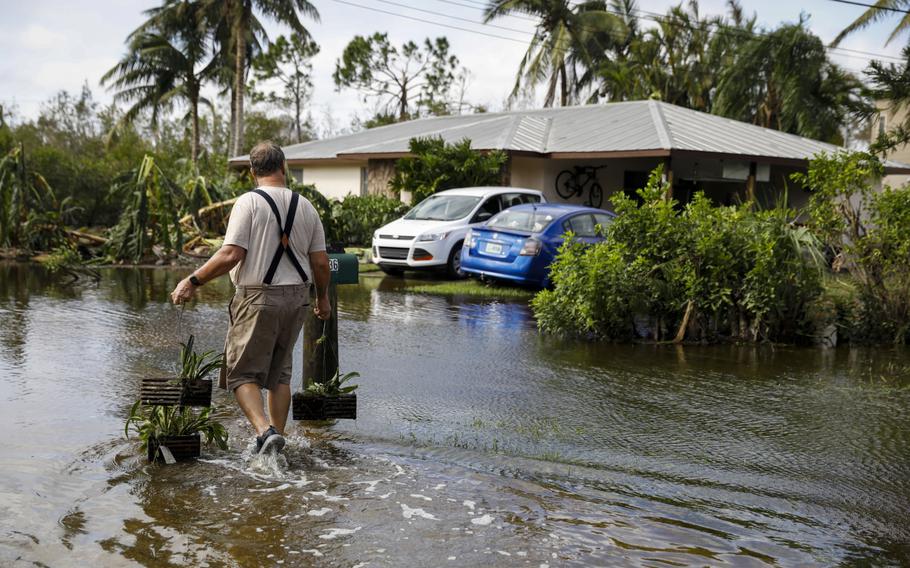
A resident walks home in the aftermath of Hurricane Ian in Fort Myers, Fla. The National Science Foundation has awarded $91.8 million to the University Corporation for Atmospheric Research to build a groundbreaking radar that could improve predictions of hurricanes and other high-impact storms and “allow researchers to see much deeper into clouds than is currently possible,” the NSF said in a news release Thursday, June 1, 2023. (Eva Marie Uzcategui)
The National Science Foundation has awarded $91.8 million to the University Corporation for Atmospheric Research to build a groundbreaking radar that could improve predictions of hurricanes and other high-impact storms and "allow researchers to see much deeper into clouds than is currently possible," the NSF said in a news release Thursday. The radar could eventually be flown by National Oceanic and Atmospheric Administration hurricane-hunter aircraft to support weather forecasting.
The radar, called the Airborne Phased Array Radar or APAR, will mount to the outside of a National Center for Atmospheric Research aircraft and provide "remarkably close 3D views of what is going on deep inside clouds and severe storms," the news release said, enabling better forecasts of hurricanes, tornadoes, strong winds, hail, heavy rain, flooding and winter storms.
Deployment of the instrument is planned for 2028, said NCAR director Everette Joseph during an online news briefing Wednesday. NCAR is a federally funded research institute managed by UCAR.
"APAR will provide a generational leap in our understanding of the formation of rain, hail and snow, as well as the processes occurring in severe convective systems and tropical cyclones," said Linnea Avallone, NSF chief officer for research facilities, during the news briefing. "The data obtained with APAR will help researchers improve models used for weather prediction and climate projection."
Thursday's funding announcement comes more than two years after NSF rejected a similar $70 million proposal because it failed to adequately describe and justify the costs of the project, The Washington Post reported at the time. NOAA officials said that the failure of the initial proposal was unexpected and called it a "significant setback."
NOAA, which has previously funded preliminary development of APAR, anticipates flying a version of the radar on new hurricane-hunter aircraft it plans to acquire, NOAA Administrator Rick Spinrad said in the news release, although that is not funded under the UCAR proposal. NOAA operates an aging fleet of aircraft that fly into hurricanes and other storms to collect data used for forecasting and research. The agency received funding this year to start the process of replacing its existing Lockheed WP-3D Orion aircraft with new Lockheed Martin C-130J aircraft, which it aims to have operating in 2030 according to a NOAA presentation posted online.
With respect to hurricanes, APAR will lead to better prediction of storm arrival, sudden changes in intensity and probable impacts, Avallone said. Tropical cyclones, which include hurricanes and tropical storms, are the most expensive of all weather and climate disasters according to NOAA, which estimates an average cost of $20.3 billion per storm.
Hurricane intensity forecasts have been slower to improve than hurricane track forecasts during the past few decades. In recent years, a number of hurricanes have rapidly intensified before making landfall, sometimes catching emergency managers and residents off-guard. For example, forecasts did not accurately predict Hurricane Ian's increase in wind speed from 115 mph to 161 mph the day before the storm struck southwest Florida last September.
A rapidly intensifying hurricane, which is defined as an increase in wind speed of at least 35 mph in 24 hours, can be harder to prepare for, especially when forecasts fail to predict such a sudden strengthening. Climate change is making rapid intensification of hurricanes more likely due in part to warming ocean waters.
"The increased severity and frequency of tropical storms and extreme precipitation events due to climate change are causing unprecedented threats to society, and APAR will help better predict severe weather events and develop solutions to move toward more resilient communities," the news release said.
Existing weather radars consist of a mechanically rotating dish and a single high-powered transmitter and receiver. APAR uses thousands of low-power transmitters and receivers to electronically scan the atmosphere, with no moving parts, providing more accurate and more frequent observations of the atmosphere while increasing the lifetime of the instrument.
APAR's three-dimensional view of what's happening inside clouds and storms compared to conventional radar has previously been likened to the difference between an MRI scan and an X-ray. The technology has been under development by NCAR and its partners since the 2010s.
The Washington Post's Jason Samenow contributed to this report.